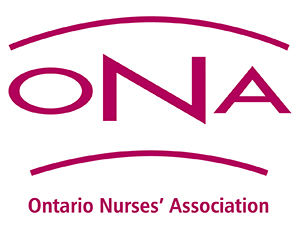Ontario Nurses' Association Says Patients Need Appropriate Hospital Funding and RN Staffing Improvements:
Flatlined hospital budgets means nursing and service cuts
TORONTO, July 14, 2014 /CNW/ - The reintroduction of a provincial budget identical to the May 1st budget has the Ontario Nurses' Association (ONA) calling for a review of hospital funding to ensure safe, quality patient care. ONA President Linda Haslam-Stroud, RN, says that while increases to community care funding are welcome, they cannot continue to come at the expense of already-underfunded hospitals.
"Front-line care providers see that patient care is suffering as a lack of funding increases for hospitals continues to result in RN job cuts, bed closures and service cuts," she said today. "ONA continues to call on the government to fully fund the key services that our patients must be able to access in public hospitals. Sending patients home quicker and sicker is harmful and costly to our patients' health and the health care system if the appropriate community supports are not in place," she said.
"The reality is that there will always be patients who are seriously ill enough to require hospital care," said Haslam-Stroud. "Cuts leave our patients in the cold when they need hospital-based acute nursing care. The infrastructure spending for hospitals is positive, but bricks and mortar mean nothing without sufficient caregivers at the bedside."
Successive years of hospital underfunding have cut millions of hours of RN care, increasing the number of high-risk patient care situations. Ontario has the second-worst RN-to-population ratio in Canada, and needs to hire 17,000 more RNs to catch up to the average ratio in Canada. The most recent statistics from the Canadian Institute for Health Information (CIHI) identify a further casualization of the RN workforce: Ontario had 554 fewer full-time RN positions in 2013; the only increase was in the number of part-time RN positions.
A number of Independent Assessment Committees (IACs) comprised of nursing experts have made strong recommendations to improve patient care in hospitals, including improved nurse staffing in emergency departments, intensive care, hemodialysis, medical and surgical units. Haslam-Stroud says that it is time these issues were addressed, adding that RN staffing capacity in the community sector also needs to be built more quickly in view of the increased number and acuity of patients being sent home from hospital.
"The best example of the impact of insufficient community sector staffing is the 32 recommendations an IAC panel made in the Windsor area just last week," she explains. "It found that the Erie-St. Clair Community Care Access Centre needed to hire seven additional care coordinators to ease the workloads of the nurses and others who were responsible for up to 267 patients each. Delays in assessing and updating care plans were sending patients to the emergency department, resulting in higher health care costs."
ONA is the union representing 60,000 front-line registered nurses and allied health professionals as well as more than 14,000 nursing student affiliates providing care in Ontario hospitals, long-term care facilities, public health, the community, industry and clinics.
SOURCE: Ontario Nurses' Association

Sheree Bond, (416) 964-8833, ext. 2430, cell: (416) 986-8240, [email protected]; Melanie Levenson, (416) 964-8833, ext. 2369, [email protected]; Visit us at: www.ona.org; Facebook.com/OntarioNurses; Twitter.com/OntarioNurses

Share this article